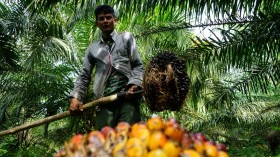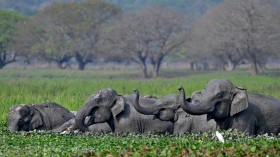A hunter from Colorado suffered severe injuries when a moose attacked him in the woods.
Dangerous Miss
The male moose attacked the hunter after the hunter's arrow missed its target. On Tuesday around noon, the man used his GPS device to send an SOS signal, according to the Larimer County Sheriff's Office.
An account owned by the sheriff's office posted on social media that When the deputy arrived, the hunter must have hiked about 1.5 miles to Long Draw Road and was receiving help from bystanders. The deputy gave the hunter first aid right away, applying a tourniquet to his arm as well as keeping him comfortable until Poudre Canyon Fire Protection District paramedics could attend to him.
The hunter had to be transported to a nearby hospital by air ambulance due to his injuries being of a life-threatening severity.
Moose Attacks
Unless provoked, moose are not typically aggressive toward humans. They do, however, attack more people compared to bears and wolves put together, albeit frequently with less severe results.
Each year, 5 to 10 people are attacked by moose in Alaska. The moose attack that happened near Long Draw Road on Tuesday was Colorado's fourth this year, according to reports.
To attract female attention, male moose may become especially aggressive during the mating season. September through October is the time when mating occurs.
A man in Idaho was attacked by a moose earlier this year while walking his dog. Moose can also become hostile if a human is with a dog.
Read also: Moose Drool Undermines Toxic Fungus in Plants
Safety Measures
After an incident in June, Shannon Schaller, deputy regional manager for Colorado Parks and Wildlife's northeast region, issued a statement urging people to ensure that all dogs are on leashes. Dogs can cause aggressive behavior, and moose and elk will pursue a dog back to its owner, creating a potentially dangerous situation.
Colorado Parks and Wildlife also suggests that the best course of action in the event of a moose charge is to flee as quickly as possible and hide behind a large rock, tree, or other objects, Newsweek reports.
Moose: Large Deers
The largest member of the Cervidae, or deer family, is the moose. According to National Geographic, they can weigh up to 1,800 pounds and grow as tall as 6.5 feet at the shoulder. The males' antlers can expand up to five feet in width.
Because they have difficulty lowering their heads to the ground due to their height, moose prefer to graze on higher grasses and shrubs. They consume shrubs and pinecones during the winter, but they also clear snow with their massive hooves to make space for moss and lichen browsing. In addition to supporting the massive animals in soft snow and muddy or marshy ground, these hooves also serve as snowshoes.
Moose were once scarce in Colorado and the surrounding areas, but Colorado Parks and Wildlife reintroduced them in the late 1970s. Approximately 3,000 moose are currently present in the state.
In North Park, Middle Park, and the vicinity of the Laramie River, limited moose hunting is permitted.
Related article: Poachers Arrested for Slaughtering Pregnant Moose, Cutting 3 Babies Outside the Womb
© 2024 NatureWorldNews.com All rights reserved. Do not reproduce without permission.



![Chimpanzee Behavior: Chimp Wars Show That Murder and Violence are Not Exclusive to Humans [Report]](https://1471793142.rsc.cdn77.org/data/thumbs/full/70473/280/157/50/40/chimpanzee-behavior-chimp-wars-show-that-murder-and-violence-are-not-exclusive-to-humans-report.jpg)

